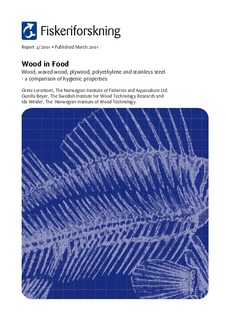| dc.contributor.author | Lorentzen, Grete Elisabeth | |
| dc.contributor.author | Beyer, Gunilla | |
| dc.contributor.author | Weider, Ida | |
| dc.date.accessioned | 2018-11-22T10:08:49Z | |
| dc.date.available | 2018-11-22T10:08:49Z | |
| dc.date.created | 2014-12-08T15:52:59Z | |
| dc.date.issued | 2001 | |
| dc.identifier.isbn | 82-7251-467-2 | |
| dc.identifier.uri | http://hdl.handle.net/11250/2574323 | |
| dc.description.abstract | The aim of this experiment is to compare the hygienic properties of different types of materials. The materials to be tested comprise standard and processed plywood, spruce, pine (planed and not planed), polyethylene, stainless steel, waxed pine/spruce and beech. After adding the microorganisms Halobacterium salinarum and microorganisms isolated from cod on the surface of the material, the hygienic properties will be measured in two parallel experiments. In the first experiment, the materials will be incubated at optimum growth conditions for the microorganisms in 2 hours or 7 days, respectively and then analysed by using the swabbing method. In the second experiment, the parallel materials which have been incubated in 2 hours or 7 days, respectively will be heated according to defined time and temperature conditions. After heating, the materials will be analysed by the swabbing method. Before the heating (after incubation), the hygienic properties of the material are interpreted as the ability to keep the microorganisms on the surface. Therefore, the material with the highest number of microorganisms detected on the surface is considered to be most hygienic. After the heating process, the hygienic properties are interpreted as a function of the incubation (time and temperature) and heating (time and temperature). After heating, the material with the lowest number of microorganisms detected on the surface is considered to be most hygienic. In general, these experiments show that the heating conditions as defined in previous experiments, are sufficient in order to attain an acceptable hygienic level for all the materials tested. The experiment show that wood, plywood or waxed wood are not less hygienic than polyethylene or stainless steel, supposed the material is heated adequate before use. The experiment shows whether or not the microorganisms may penetrate the surface of the materials. Processed plywood, polyethylene or stainless steel is less exposed to penetration; a larger amount of microorganisms remains on the surface during incubation compared to the other materials tested. Consequently, it is considered that processed plywood have equal hygienic properties to polyethylene or stainless steel. | |
| dc.description.abstract | Wood, waxed wood, plywood, polyethylene and stainless steel - a comparison of hygienic properties | |
| dc.language.iso | eng | |
| dc.publisher | Nofima AS (tidligere Fiskeriforskning) | |
| dc.relation.ispartof | Nofima rapportserie | |
| dc.relation.ispartofseries | Nofima rapportserie | |
| dc.relation.uri | https://nofimaas.sharepoint.com/sites/public/_layouts/15/guestaccess.aspx?guestaccesstoken=oQcb8BbCwOhdodjdwlgyPThune%2bfIw%2fnPuSxsWrBzVw%3d&docid=0091e381b4f034e0c8b07235bc8370f0b | |
| dc.title | Wood, waxed wood, plywood, polyethylene and stainless steel - a comparison of hygienic properties | |
| dc.title.alternative | Wood, waxed wood, plywood, polyethylene and stainless steel - a comparison of hygienic properties | |
| dc.type | Research report | |
| dc.description.version | publishedVersion | |
| dc.source.pagenumber | 47 | |
| dc.source.issue | 4/2001 | |
| dc.identifier.cristin | 1182335 | |
| dc.relation.project | Nofima AS: 8495 | |
| cristin.unitcode | 7543,2,5,0 | |
| cristin.unitname | Sjømatindustri | |
| cristin.ispublished | true | |
| cristin.fulltext | original | |
